 JTF (just the facts): 88 color prints (and one wall sized montage) with white frames, arrayed in the main gallery space at Aperture. An additional 16 images shown in the entry and near the reception desk at Bloomsbury. The combined exhibition is a mixture of vintage C-prints and Polaroids and modern pigment prints. All of the images are from the 1970s and 1980s. (Installation shot of Aperture show at right.)
JTF (just the facts): 88 color prints (and one wall sized montage) with white frames, arrayed in the main gallery space at Aperture. An additional 16 images shown in the entry and near the reception desk at Bloomsbury. The combined exhibition is a mixture of vintage C-prints and Polaroids and modern pigment prints. All of the images are from the 1970s and 1980s. (Installation shot of Aperture show at right.)
Auction Previews: Heritage, Millon, and Bloomsbury
Here are three more upcoming photography auctions that are worth a look. We won’t have time to do the usual thorough analysis of these sales, but wanted to provide links just the same:
Heritage Auctions
Vintage & Contemporary Photography
December 12
348 lots of photography.
Millon & Associes
Photographie Contemporaine
December 13
113 lots of contemporary photography in a sale also offering design/furniture.
Bloomsbury Auctions
20th Century Arts, New York
December 17
118 lots of photography in a sale also offering prints/multiples.
Cindy Sherman, History Portraits @Skarstedt
 JTF (just the facts): 18 color portraits, all larger than life sized, negatives from 1988 through 1990, displayed in 3 separate rooms on the first and second floors of the gallery. The works are made in editions of 6. (Installation shot at right.)
JTF (just the facts): 18 color portraits, all larger than life sized, negatives from 1988 through 1990, displayed in 3 separate rooms on the first and second floors of the gallery. The works are made in editions of 6. (Installation shot at right.)
Auction Results: Bassenge, Van Ham, and Lempertz
Three additional German auction houses had their photography sales last week: Galerie Bassenge (Berlin), Van Ham Kunstauktionen (Cologne) and Kunsthaus Lempertz (Cologne). In general, the outcomes were comparable to the rest of the season around the world. The results are below (all results include the buyer’s premium):
Galerie Bassenge
Total Lots: 662
Pre Sale High Total Estimate: 549140 Euros
Total Lots Sold: 427
Total Lots Bought In: 235
Buy In %: 35.50%
Total Sale Proceeds: 428900 Euros
The buy-in rate in this sale is artificially high, as the the photo book lots all sold well at very low prices, which made the numbers for the sale as a whole look better.
Here is the breakdown (using the Low, Mid, and High definitions from the preview post, here):
Low Total Lots: 660
Low Sold: 426
Low Bought In: 234
Buy In %: 35.45%
Total Low Estimate: 530140 Euros
Total Low Sold: 420780 Euros
Mid Total Lots: 2
Mid Sold: 1
Mid Bought In: 1
Buy In %: 50.00%
Total Mid Estimate: 19000 Euros
Total Mid Sold: 8120 Euros
High Total Lots: 0
High Sold: 0
High Bought In: 0
Buy In %: NA
Total High Estimate: 0
Total High Sold: 0
All in, this sale earned Bassenge a second place finish among the German houses, behind Villa Grisebach.
Van Ham Kunstauktionen
Total Lots: 422
Pre Sale High Total Estimate: 738440 Euros
Total Lots Sold: 179
Total Lots Bought In: 243
Buy In %: 57.58%
Total Sale Proceeds: 381844 Euros
Not much to say here, just a disappointing outing in a tough market.
Here is the breakdown (using the Low, Mid, and High definitions from the preview post, here):
Low Total Lots: 409
Low Sold: 174
Low Bought In: 235
Buy In %: 57.46%
Total Low Estimate: 542440 Euros
Total Low Sold: 260469 Euros
Mid Total Lots: 12
Mid Sold: 4
Mid Bought In: 8
Buy In %: 66.67%
Total Mid Estimate: 146000 Euros
Total Mid Sold: 61375 Euros
High Total Lots: 1
High Sold: 1
High Bought In: 0
Buy In %: 00.00%
Total High Estimate: 50000 Euros
Total High Sold: 60000 Euros
Kunsthaus Lempertz
Total Lots: 220
Pre Sale High Total Estimate: 315300 Euros
Total Lots Sold: 73
Total Lots Bought In: 147
Buy In %: 66.82%
Total Sale Proceeds: 181932 Euros
With only approximately 30000 Euros of premium, this sale likely didn’t break even against its costs. It was the worst outcome of the season (just nosing out Sotheby’s London).
The photography lots in the Contemporary Art sale the same day brought in additional proceeds of 117960 Euros (against an estimate of 315300 Euros, with a 61.22% buy-in rate).
Here is the breakdown of photography sale only (using the Low, Mid, and High definitions from the preview post, here):
Low Total Lots: 214
Low Sold: 71
Low Bought In: 143
Buy In %: 57.46%
Total Low Estimate: 366150 Euros
Total Low Sold: 134172 Euros
Mid Total Lots: 6
Mid Sold: 2
Mid Bought In: 4
Buy In %: 66.67%
Total Mid Estimate: 52000 Euros
Total Mid Sold: 47760 Euros
High Total Lots: 0
High Sold: 0
High Bought In: 0
Buy In %: NA
Total High Estimate: 0 Euros
Total High Sold: 0 Euros
Overall, the German fall season was surprisingly weak, and was likely hindered by falling at the end of the run of sales. With potential buyers being much more careful and picky, there just wasn’t enough quality material in these sales to generate real interest.
Auction Preview: Icons of Glamour and Style: The Constantiner Collection, December 16/17, 2008 @Christie’s
 Since we are not collectors of fashion photography, we have always wondered who was buying all of the glamour images by Helmut Newton, Irving Penn, William Klein, Herb Ritts and a handful of others that can consistently be found in sale after sale, year after year, ringing up strong prices. With the arrival of this well-produced catalog on our doorstep, we now have at least one good answer to that question.
Since we are not collectors of fashion photography, we have always wondered who was buying all of the glamour images by Helmut Newton, Irving Penn, William Klein, Herb Ritts and a handful of others that can consistently be found in sale after sale, year after year, ringing up strong prices. With the arrival of this well-produced catalog on our doorstep, we now have at least one good answer to that question.
Regardless of whether these kinds of images are your particular passion, this is an amazing collection. Within its defined sandbox (fashion and glamour images), it has all the hallmarks of a great collection: depth (320 images on sale here, with a comprehensive 89 lots by Helmut Newton, from small Polaroids to wall-sized murals, including a large number of portfolios), breadth (104 individual photographers represented by at least one image), and many iconic and rare masterpiece images that define the genre. By our count, there are 41 lots of Marilyn Monroe pictures, so if you ever felt the need for an image of Marilyn in your collection, now is the time to find one. Mixed in among the celebrities, couture and nudes are a handful of standout images of New York. All in, with a total high estimate of $11020500, this is a big sale.
Here’s the overall price breakdown:
Total Low Lots (high estimate below $10000): 146
Total Low Estimate (sum of high estimates of Low lots): $784500
Total Mid Lots (high estimate between $10000 and $50000): 127
Total Mid Estimate: $2816000
Total High Lots (high estimate above $50000): 47
Total High Estimate: $7420000
This sale has power in all directions, but particularly in the Mid and High ranges. Given the volatile financial markets, the timing of this sale isn’t the greatest. It’s a fabulous collection and deserves to sell well; it will be interesting to see how the work actually performs. In the small print, the catalog notes that “Christie’s has a direct financial interest in all lots offered in this sale”, so clearly the Constantiners got a guarantee for the whole package, regardless of the outcome.
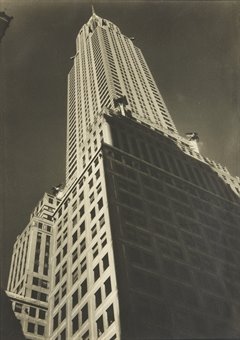
For our particular collection, here are a few of interest:
- Lot 25 Umbo, New York, Third Avenue, 1952
- Lot 26 Margaret Bourke-White, Chrysler Building (Facade), c1930 (image at right)
- Lot 41 Karl Struss, Cables, 1910-1912
Given the scope of this collection, this will be a must-see preview, even if you’re not a buyer. It seems unlikely that such a staggering group of fashion photography will be on view anywhere else any time soon (museums included). So gather up some friends and go down to see this preview, and catch the tree at Rockefeller Center as a bonus.
Andreas Gursky @Matthew Marks
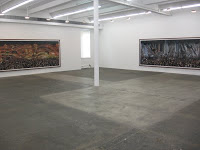 JTF (just the facts): 4 large scale color photographs (on the order of 8 x 16 feet), displayed in the main, natural lit gallery. (Installation shot at right.) A fifth photograph is being shown (on its own) at the other gallery location.
JTF (just the facts): 4 large scale color photographs (on the order of 8 x 16 feet), displayed in the main, natural lit gallery. (Installation shot at right.) A fifth photograph is being shown (on its own) at the other gallery location.
The group of new works in this exhibit are all taken inside the Cocoon Club in Frankfurt, and these pictures travel the same road as other previous Gursky works inside techno nightclubs (seas of people, waves of movement, the interplay of individuals and crowds, theatrical lighting). As such, beyond one image that is a less than interesting self portrait of the artist and his son, there isn’t anything new here and none of these pictures match the greatness of some his better know works. All the images are quite dark and muddy, and even the ones with large crowds and wild lights don’t really jump off the wall; they actually draw you in to look more closely at the details. Heading into this exhibit, we were eagerly expecting to be wowed by the new Gursky show; and while his works are always visually interesting and carefully crafted, and we are overall fans of his art, unfortunately, these particular pitcures didn’t move us and the show was ultimately a let down.
Cornell Capa: Concerned Photographer @ICP
JTF (just the facts): 60 black and white images, taken between 1953 and 1973, hung in groups as eight photo essays, in the main gallery. Topics/locations include : Guatelama (1953), Argentina (1955), Nicaragua (1956), Ecuador (1956), “Farewell to Eden” Peru/Brazil border region (1961), Robert Kennedy (1964), Attica (1972), and “Margins of Life” El Salvador/Honduras 1970-1973. 3 glass cases include copies of books, magazine spreads, and letters.
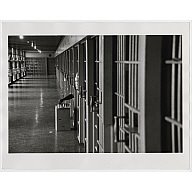 found pauses and moments of quiet expression. His pictures tell complex and under reported stories with a clear humanitarian impulse. While there are few iconic images among Capa’s work and many pictures feel drawn straight from a newspaper, when examined with care and patience in the context of the group of images from a single story as a whole, there is a remarkable consistency of quality and vision. He took on some tough assignments and made them into elegant and powerful pictorial stories. (Inmates playing chess from prison cells, Attica Correctional Facility, Attica, New York, 1972 at right.)
found pauses and moments of quiet expression. His pictures tell complex and under reported stories with a clear humanitarian impulse. While there are few iconic images among Capa’s work and many pictures feel drawn straight from a newspaper, when examined with care and patience in the context of the group of images from a single story as a whole, there is a remarkable consistency of quality and vision. He took on some tough assignments and made them into elegant and powerful pictorial stories. (Inmates playing chess from prison cells, Attica Correctional Facility, Attica, New York, 1972 at right.)Living with the Dead: W. Eugene Smith and World War II @ICP
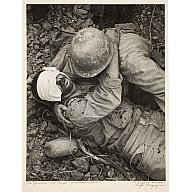 JTF (just the facts): 11 black and white exhibition prints of World War II (all from 1943-1945), recently donated by Smith’s assistant, Leslie Teicholz. Hung in a small gallery with dark grey walls on the museum’s main floor, each image spotlit/backlit in an otherwise dark room. (No Speeches – No Flags – No Martial Music, 1945, at right.)
JTF (just the facts): 11 black and white exhibition prints of World War II (all from 1943-1945), recently donated by Smith’s assistant, Leslie Teicholz. Hung in a small gallery with dark grey walls on the museum’s main floor, each image spotlit/backlit in an otherwise dark room. (No Speeches – No Flags – No Martial Music, 1945, at right.)
America and the Tintype @ICP
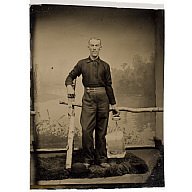 JTF (just the facts): 129 small tintype images, framed separately, and arrayed in groups through one small room (painted yellow) on the main floor of the museum. Divided into four sections: “Democratic Visages”, “Workers’ Portraits”, “Stereotypical Tintypes”, and “The Tintype and Leisure”. (Iceman, Unidentified Photographer, c1875 at right.)
JTF (just the facts): 129 small tintype images, framed separately, and arrayed in groups through one small room (painted yellow) on the main floor of the museum. Divided into four sections: “Democratic Visages”, “Workers’ Portraits”, “Stereotypical Tintypes”, and “The Tintype and Leisure”. (Iceman, Unidentified Photographer, c1875 at right.)
Auction Preview: Photographic Literature & Photographs, December 11, 2008 @Swann
 It was only a handful of years ago that Swann Galleries had its first sale of photo books, and now Photographic Literature has become a category of its own and many of the auction houses are getting in on the action. This sale is a hybrid, with a combination of rare books (291 lots) and photographs (110 lots) on offer. The total high estimate for the sale is $1233650 (plus one lot with price on request).
It was only a handful of years ago that Swann Galleries had its first sale of photo books, and now Photographic Literature has become a category of its own and many of the auction houses are getting in on the action. This sale is a hybrid, with a combination of rare books (291 lots) and photographs (110 lots) on offer. The total high estimate for the sale is $1233650 (plus one lot with price on request).
Total Mid Estimate: $280000
Total High Estimate: $75000
- Lot 21 Lewis Baltz, Candlestick Point
- Lot 48 Harry Callahan, Photographs (El Mochuelo Gallery)
- Lot 100 Lee Friedlander, Flowers and Trees
- Lot 106 Jaromir Funke, Fotografie
- Lot 124 Eikoh Hosoe, Embrace
- Lot 135 Andre Kertesz, Day of Paris
- Lot 205 Ed Ruscha, Every Building on the Sunset Strip
- Lot 206 Ed Ruscha, Thirtyfour Parking Lots
- Lot 209 Ed Ruscha, Twentysix Gasoline Stations
- Lot 234 Aaron Siskind, Photographs (Horizon)
- Lot 252 Hiroshi Sugimoto, Theaters
- Lot 259 Shomei Tomatsu, Oo! Shinjuku
- Lot 278 Edward Weston, Photographs (Conger)
Art Basel Miami Beach and Others
 For those of you making the trek to Miami this week for the various fairs (or who are perhaps already there), while we won’t be joining you this year, we expect there will be plenty of great and terrible work on display. Here’s our view of the short list:
For those of you making the trek to Miami this week for the various fairs (or who are perhaps already there), while we won’t be joining you this year, we expect there will be plenty of great and terrible work on display. Here’s our view of the short list:
A few of the major photography players can be found at Art Basel Miami Beach (Howard Greenberg, Fraenkel, Edwynn Houk, and Kicken Berlin), mixed in with the cream of the crop of the world’s best contemporary art dealers, almost all of which show photography periodically these days. This will certainly be the venue for the top end contemporary photography, along with some choice vintage pieces in the background.
With the demise of the short lived AIPAD Miami Beach edition, the rest of the photography galleries have been spread to the wind, many ending up at Art Miami (Barry Singer, Catherine Edelman, Cohen Amador, Fay Gold, Michael Hoppen, Hasted Hunt, PDNB, Silverstein Photography, Stephen Bulger, Rick Wester, and Yancey Richardson among others). Pulse has a few more worth visiting (Yossi Milo, Robert Mann, Julie Saul). Photo Miami has another fifty or so photo galleries, many of which are unknown to us, but likely worth a quick look as well.
And don’t forget to swing by and see the Margulies Collection at The Warehouse and the Rubell Family Collection, two great private collections of contemporary art (including photography).
Auction Results: Christie’s South Kensington and Villa Grisebach
There were two more photography sales during the short Thanksgiving week: Christie’s South Kensington (London) and Villa Grisebach (Berlin). The results are below (all results include the buyer’s premium):
Christie’s South Kensington
Total Lots: 168
Pre Sale Low Total Estimate: 363400 Pounds
Pre Sale High Total Estimate: 535000 Pounds
Total Lots Sold: 119
Total Lots Bought In: 49
Buy In %: 29.17%
Total Sale Proceeds: 348727 Pounds
Of all the various owner sales this season, this sale was closest to its pre-sale Low estimate in terms of overall proceeds, with a surprisingly low buy-in rate (bested only by the single owner Eggleston and Jammes sales earlier in the fall).
Here is the breakdown (using the Low, Mid, and High definitions from the preview post, here):
Low Total Lots: 146
Low Sold: 107
Low Bought In: 39
Buy In %: 26.71%
Total Low Estimate: 393000 Pounds
Total Low Sold: 274227 Pounds
Mid Total Lots: 22
Mid Sold: 12
Mid Bought In: 10
Buy In %: 45.45%
Total Mid Estimate: 142000 Pounds
Total Mid Sold: 74500 Pounds
High Total Lots: 0
High Sold: 0
High Bought In: 0
Buy In %: NA
Total High Estimate: 0
Total High Sold: 0
Given a mixed bag of less than amazing material (from our perspective), this sale performed unexpectedly well.
Villa Grisebach
Total Lots: 241
Pre Sale Low Total Estimate: 583300 Euros
Pre Sale High Total Estimate: 822200 Euros
Total Lots Sold: 140
Total Lots Bought In: 101
Buy In %: 41.91%
Total Sale Proceeds: 453805 Euros
Villa Grisebach is the first of the German auction houses to have its photography sale this season, so we don’t yet have a pattern for what is happening in that micro market. In the context of the wider US and London markets, this sale performed right in line with the prevailing somber mood.
Here is the breakdown (using the Low, Mid, and High definitions from the preview post, here):
Low Total Lots: 223
Low Sold: 131
Low Bought In: 92
Buy In %: 41.26%
Total Low Estimate: 545200 Euros
Total Low Sold: 335995 Euros
Mid Total Lots: 16
Mid Sold: 8
Mid Bought In: 8
Buy In %: 50.00%
Total Mid Estimate: 167000 Euros
Total Mid Sold: 70210 Euros
High Total Lots: 2
High Sold: 1
High Bought In: 1
Buy In %: 50.00%
Total High Estimate: 110000 Euros
Total High Sold: 47600 Euros
While there was weakness across the board, this sale had a few more positive outliers (where the realized price was meaningfully higher than the high estimate) than most of the other sales, and these lots helped raise the totals and back fill for those lots that didn’t sell.